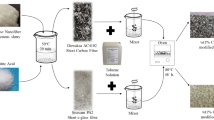Abstract
The mechanism of a polyurea coating on the flexural strength of coated ceramic tiles was studied by three-point bending together with FEM simulation. The influence of Young’s modulus and the coating position of the polyurea on the coated ceramic sample were investigated. The back-coated ceramic with lower modulus polyurea (PUR240 MPa) could show higher flexural strength due to the cushion effect that reduces tensile stress around the bottom center of the substrate. The higher modulus polyurea coating (PUR866 MPa) has a significant influence on the flexural strength of the coated ceramic sample. In back-coating, the higher modulus coating increased the flexural strength of the coated ceramic sample by nearly twofold, compared to lower modulus. This higher modulus coating enhanced the stress distribution as well as storage energy in the sample. According to the results of the FEM simulation, the mechanism which influences the stress distribution within samples during the three-point bending test was investigated. The cushion effect shows a main contribution in stress distribution by a lower modulus coating. The cushion effect occurs near the supporting pins and contributes to the stress dissipation and the reduction of stress concentration at the center-bottom of the substrate. In contrast, a thickening effect plays an important role in the case of higher modulus polyurea coatings. The center-back-coated with higher modulus polyurea acts to increase the thickness of the ceramics and dominates the effect on the flexural strength of the coated ceramic sample.














Similar content being viewed by others
References
Primeaux II, DJ, “Spray Polyurea—Versatile High Performance Elastomer for the Polyurethane Industry”, Polyurethanes’89, the 32nd Technical/Marketing Conference, SPI, San Francisco, California, October 1989
Feng, L, Iroh, JO, “Corrosion Resistance and Lifetime of Polyimide-b-Polyurea Novel Copolymer Coating.” Prog. Org. Coat., 77 590–599 (2014)
LeBlanc, J, Gardner, N, Shukla, A, “Effect of Polyurea Coatings on the Response of Curved E-Glass/Vinyl Ester Composite Panels to Underwater Explosive Loading.” Compos. Part B, 44 565–574 (2013)
Mohotti, D, Ngo, T, Raman, SN, Ali, M, Mendis, P, “Plastic Deformation of Polyurea Coated Composite Aluminium Plates Subjected to Low Velocity Impact.” Mater. Des., 56 696–713 (2014)
Broekaert, M, “Modified MDI-Prepolymers Improve the Initial Physical Properties and Reduce the ‘In-Service’ Time of Aromatic Polyurea Coatings.” Proceedings of the 6th Nurnberg Congress—Creative Advances in Coatings Technology, Nurnberg April 2001, p. 761.
Xue, L, Mock, W, Jr, Belytschko, T, “Penetration of DH-36 Steel Plates with and Without Polyurea Coating.” Mech. Mater., 42 981–1003 (2010)
Toutanji, HA, Choi, H, Wong, D, Gilbert, JA, Alldredge, DJ, “Applying a Polyurea Coating to High-Performance Organic Cementitious Materials.” Constr. Build. Mater., 38 1170–1179 (2013)
Grujicic, M, Pandurangan, B, He, T, Cheeseman, BA, Yen, CF, Randow, CL, “Computational Investigation of Impact Energy Absorption Capability of Polyurea Coatings via Deformation-Induced Glass Transition.” Mater. Sci. Eng. A, 527 7741–7751 (2010)
Barsoum, R, “Dynamic Response and Failure Mechanisms of Layered Ceramic-Elastomer-Polymer/Metal Composites”, pp. 2–4. University of California (2010)
Imbalzano, G, Ngo, T, Tran, P, “A Numerical Study of Auxetic Composite Panels Under Blast Loadings.” Compos. Struct., 135 339–352 (2015)
Imbalzano, G, Tran, P, Ngo, TD, Lee, PVS, “Three-Dimensional Modelling of Auxetic Sandwich Panels for Localised Impact Resistance.” J. Sandw. Struct. Mater., 19 (3) 291–316 (2015)
Raman, SN, Ngo, T, Lu, J, Mendis, P, “Experimental Investigation on the Tensile Behavior of Polyurea at High Strain Rates.” Mater. Des., 50 124–129 (2013)
Mohotti, D, Ngo, T, Mendis, P, Raman, SN, “Polyurea Coated Composite Aluminium Plates Subjected to High Velocity Projectile Impact.” Mater. Des., 52 1–16 (2013)
Taylor, JR, Bull, AC, “Ceramics Glaze Technology.” Chapter 7 in Glaze Formation, pp. 125. Institute of Ceramics & Pergamon Press, New York (1986)
Ryan, W, Radford, C, “Whitewares.” Testing and Quality Control, Institute of Ceramics & Pergamon Press, New York (1987)
Standard Test Method for Flexural Strength of Advanced Ceramics at Ambient Temperature, ASTM C1161-13
Green, DJ, “An Introduction to the Mechanical Properties of Ceramics.” Chapter 9 in Strengthend Engineering Design, pp. 286–288. Cambridge University Press, UK (1998)
Riccardi, CC, Vallo, CI, “Estimation of Weibull Parameters for the Flexural Strength of PMMA-Based Bone Cements.” Polym. Eng. Sci., 42 (6) 1260–1273 (2002)
Bhaduri, A, “Mechanical Properties and Working of Metals and Alloys.” Chapter 2 in Compression, pp. 98–106. Springer, Singapore (2018)
Schoenfelder, S, Ebert, M, Landesberger, C, Bock, K, Bagdahn, J, “Investigations of the Influence of Dicing Techniques on the Strength Properties of Thin Silicon.” J. Microelectron. Reliab., 47 (2–3) 168–178 (2007)
Hafeez, F, Arif, M, “Engineering Practical Book Vol-II: Basic Mechanics and Science of Materials.” pp. 62–65. Educreation Publishing, New Delhi (2011)
Davidge, RW, “Mechanical Behaviour of Ceramics.” Chapter 9 in Engineering Design Data, pp. 152. Cambridge, New York (1979)
Greaves, GN, Greer, AL, Lakes, RS, Rouxel, T, “Poisson’s Ratio and Modern Materials.” Nat. Mater., 10 823–837 (2011)
Orlov, V, “Computer Simulation of Optimal Thickness of Polyurea Coating Using for Trenchless Renovation of Potable Water Pipes.” J. Procedia Eng., 165 1168–1175 (2016)
Author information
Authors and Affiliations
Corresponding author
Electronic supplementary material
Below is the link to the electronic supplementary material.
Rights and permissions
About this article
Cite this article
Kamonchaivanich, K., Kuboyama, K. & Ougizawa, T. Effect of elastic modulus and position of polyurea coating on flexural strength of coated ceramic tiles by experiments and finite element analysis. J Coat Technol Res 16, 1201–1211 (2019). https://doi.org/10.1007/s11998-018-00170-6
Published:
Issue Date:
DOI: https://doi.org/10.1007/s11998-018-00170-6




